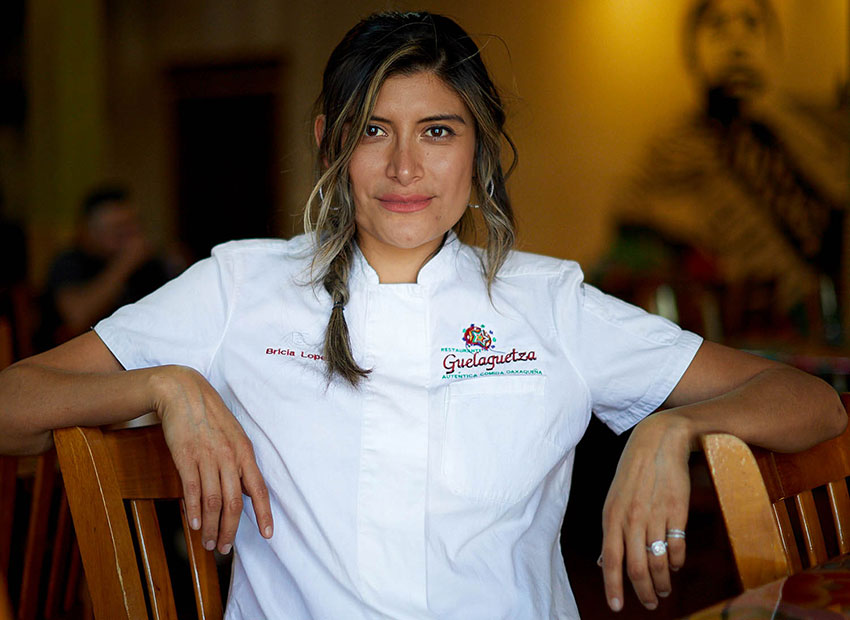From moles to nopales, a new cookbook introduces readers to the regional cuisine of Oaxaca in its many varieties: Oaxaca: Home Cooking from the Heart of Mexico by Bricia Lopez.
Lopez’s Oaxacan immigrant parents established the Guelaguetza restaurant in Los Angeles 25 years ago. She sees the current moment as opportune to broaden awareness in the United States of regional Mexican food, including that of her family’s home state.
“Oaxaca has such a great variety of foods and recipes,” Lopez told Mexico News Daily in a phone interview. “You can live there a year and eat something different every single day.” And in this southeastern Mexican state, “there are no rules (about) what you can have for lunch or dinner.”
Lopez worked on the book with Javier Cabral for about a year. Recently released by Abrams Books, it comes out as Guelaguetza celebrates the quarter-century mark.
“It’s a combination of my mother’s and father’s stories coming to the U.S., the ups and downs of business, the trajectory of an immigrant family,” she said.

In the introduction, Lopez notes that the word guelaguetza comes from the indigenous Zapotec spoken throughout her home state and “embodies one of the core values of Oaxacan culture: to always share what you have with others no matter how much or how little you may have.”
She described her family’s restaurant as consistently sharing many features of Oaxaca in LA. “It’s the first restaurant that really focused on Oaxacan cuisine, culture, art and music,” she said of the popular eatery created by her parents, Fernando Lopez and Maria de Jesus Monterrubio.
“It’s already been two generations now of people coming in … It’s grown awareness of Mexican foods (and the) different regions that Mexico has to offer,” including “other states, not just Oaxaca.”
The book notes that the late food writer Jonathan Gold called Guelaguetza “the best Oaxacan restaurant in the country.”
“Jonathan Gold had not just [an influence on] Oaxacan cuisine, but I think LA cuisine, immigrant cuisine in LA,” Lopez said. “He had a deep sense and commitment to the communities growing in LA. He was the first journalist to not just write about, but show an interest in our culture.”
Famous for being the self-described land of seven moles, Oaxaca is also a renowned hub of mezcal, and readers will discover plenty of recipes for both.
“I think as far as complex [recipes in the book], I always lean toward the mole,” Lopez said. “The ingredients are complex in flavor, not as much in the process.”
She added that the six mole recipes in the book are “common knowledge in Oaxaca.”
Mezcal, meanwhile, is the “drink of choice at the restaurant,” she noted.
“Before tequila, there was mezcal,” she said of the centuries-old spirit distilled from the agave plant. “It’s the essence of Oaxacan culture. It’s not the national spirit, but definitely the state spirit.”
She noted that 80% of mezcal today is made in Oaxaca.
But as Lopez writes in the book’s introduction, Oaxaca goes well beyond mole and mezcal: “The corn, the chiles, the herbs and spices, and the chocolate that form the foundation of the food here establish this beautiful state as the culinary heart and soul of the Mexican nation.”
![]()
She said the book includes “a section that’s just on salsa, which is easy to make.” In particular she mentioned her chileajo, calling it one of the simpler recipes in the book — “vegetables tossed in guajillo sauce,” with aguas frescas (fresh fruit beverages) and salsas.
Still other recipes shed light on dishes that may be less familiar to readers in the U.S., with ingredients such as nopales and even grasshoppers.
You can have nopales for breakfast (eggs with nopalitos), or with mole (white bean yellow mole with nopal and dried shrimp). Other possibilities are the chicken in salsa verde with potatoes and nopales and the nopalito salad with guajillo chilies.
“I think in LA, ingredients like [that] are easy to find,” Lopez said of the prickly pear. “Nowadays as [part of] a Mexican cultural and culinary scene, you really just expect [to find them] throughout the country. They’re tender. You can cure or boil them. They’re a very hardy [source] of fiber and delicious.”
The book also includes two recipes for grasshoppers, or chapulines: chapulín and chicharrón (pork rind) tacos and chapulín salsa.
“Grasshoppers are very popular in Oaxaca,” Lopez said. “They are obviously a wild insect that has one of the highest concentrations of protein, a very sustainable source” and “a little bit acidic in texture.”
They’re also available at “any Oaxacan market in LA,” she added, calling chapulines “part of a Oaxacan culture. I don’t think they’re weird at all.”
Lopez also hopes her book will dispel what she described as the racist notion that Mexican food is cheap. She said she hopes people start “paying attention to all the labor, all the ingredients” involved in its preparation.
Mexican food is at a crossroads in the U.S., she said, not unlike where Italian food used to be. As she explained, there is a rise in Mexican restaurants in the U.S., as well as more young chefs interested in Mexican cuisine.
“I think people are more open,” she said, adding that people are increasingly “able to pay homage — and dollars — to Mexican food.”
She hopes that her book will help in this regard.
“I think it really is a story that anyone from an immigrant family can relate to,” Lopez said, “how we put our family stories first, and complement it with recipes we grew up eating.”
